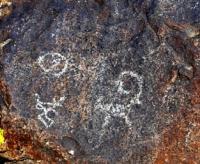Вы здесь
Petroglyphs of Kerme-Too.

Travels along the Silk Road of Kyrgyzstan.
“An ancient burial site will always hold clues as to who the people were, and to who we are”
Anthony T. Hincks.
Monuments of history and culture of Kyrgyzstan.
Petroglyphs of Kerme-Too, a limestone mountain, is an eastern edge of the Chil-Mayram Range 2km west of Sulayman-Too. Geographic coordinates: NL 72 44 19.7, EL 40 31 14.7; altitude: 1,179m. Six caves were surveyed on the eastern and southern slopes.
About 20 solar signs, web-like images and various engravings were found on their walls, floors and ceilings. The most interesting petroglyphs were found in the caves in the middle of the northern slope. Each has a local name and a second, given by famous regional ethnographers Cheylytko V.R. and Dyadyuchenko L.B.
Ritual fire traces are noted everywhere; the floor of one of the caves on the southern slope is polished by the feet of many pilgrims. On the eastern side of the cave is another hill also with traces of polishing and a narrow groove, used, apparently, for ritual libations.
All this testifies to the long-term functioning of these caves as cult sites. Zhylaan Unkur cave (Kyrgyz for “cave of snakes”). Above the entrance to the cave, a rock overhang protrudes for 0.5m. Drawings are chiseled outside, on patinated vertical rock surfaces in front of the entrance.
There are 27 drawings: solar symbols -circles, circle with six diverging rays -, one of which interpreted as a snake's head; a square, divided into four sections; a pair of arched signs and parallel lines, dots, shapes, and tree-like shapes, and snakes made in a manner typical to Sulayman-Too.
All recorded drawings repeat rock art motifs at Sulayman-Too. Some are partially refreshed. On the right side, above the entrance, two natural cup-holes have traces of abrading of their surface. A cave with a “balcony” is located slightly above the previous one and 15m west of it.
It consists of a lower part with a large entrance and a protrusion or “balcony” facing north and 2.5m above the entrance. On the western wall, a first group of drawings includes two circles and two commashaped signs. Similar circles are chiseled on the floor of the “balcony”; the largest is 7.5cm in diameter.
The eastern and southern walls also have small circles and engravings in the shape of webs and nets. Single solar signs in the form of circles are found in different locations of the cave. A calcite cave west of the previous one has rock art on its arch and walls similar to the drawings described.
In addition, engravings in the form of a web, square net, cross with a diverse number of diverging rays are on the cave roof. The first effort to preserve Osh Oasis petroglyphs was made at Sulayman-Too under the National Program “Osh-3000” in 1998 - 2000 (Sitnikova 2004: 135).
Now, Sulayman-Too and Ayrymach-Too (Surottuu-Tash) are included in the “State List of Historical and Cultural of National Importance” (2002) and receive legal protection. Sulayman-Too Mountain, as part of National Historical and Archeological Museum Complex, was included in 2009 in UNESCO’s World Heritage List under the category of sacred mountain.
In 2008, Ayrymach-Too and Kerme-Too were added to the buffer zone of Sulayman-Too. Kerme-Too is also on the list of sites of local importance.
Authority:
«Rock Art in Kyrgyzstan». Bakyt Amanbaeva, Aiday Suleymanova, Chynarbek Zholdoshev.
Photos by
Alexander Petrov.







